Held family appreciates lifelong education, grassroots process of Farmers Union

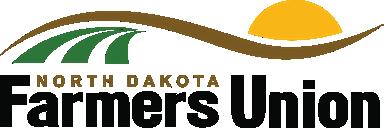
NDFU
farmer MAY 2024 • ndfu.org 'PRICELESS'
union
Brent Vik
I grew up in Langdon and graduated from Minot State University. My family is from the Minot area. I moved to Grand Forks in 1996 and married my wife Kristen in 2003. In 2010, my stepson Alec, Kristen and I built a home six miles out of town near where she grew up.
We absolutely love living in the country with our four Boston terriers (six when Alec brings his out). In 2013, I started my career with Farmers Union Insurance. What I love most about our industry is educating and helping our clients. Networking within the community is an important part of my business. I’m on multiple committees with the board of realtors and the Grand Forks Chamber of Commerce, as well as a few other community organizations.
Lynn Kadlec
I was born and raised on the family farm located just outside the small town of Pisek, N.D. Currently, I reside in Grand Forks with my wife Larissa. I have been an agent for eight years. Prior to that, I was employed by Case New Holland Corporation based in Racine, Wis., and South Dakota.
I enjoy still having connections to agriculture as my entire background has involved dealing with farms and farmers. I also enjoy meeting and visiting with people.

I enjoy volunteering for the Salvation Army and their “Big Ring” event and help support the local animal shelter, as we have two dogs of our own.
Matt Eggl
I grew up in Cando and graduated from the University of Minnesota – Crookston. I lived in Jamestown for 10 years where I met my wife, Katie. We were married in 2010 and we now have three children: Easton, Elsie and Eli. We moved to Grand Forks in April 2022 when I started my career with Farmers Union Insurance.
I am involved in the Grand Forks youth hockey association, as well as being part of the Greater Grand Forks Young Professionals. What I love about Farmers Union Insurance is helping our clients find the right coverage to protect them for their individual needs.




• PO Box 2136 Jamestown, ND 58402-2136
mailed this issue: 36,342 • USPS 016-211
2 • May 2024 • Union Farmer SIMPLY DIFFERENT! Vik-Kadlec-Eggl Agency 1551
PH:
GET TO KNOW A FARMERS UNION INSURANCE AGENCY
North Dakota Farmers Union @NDFarmersUnion CONNECT WITH US Read the Union Farmer online at https://ndfu.org/news/union-farmer UNION FARMER MAGAZINE The UNION FARMER is published monthly by North Dakota Farmers Union at 1415 12th Ave SE, Jamestown, ND 58401. EDITOR: Chris Aarhus 800-366-6338 caarhus@ndfu.org Annual subscription is $30 with membership. Periodicals postage paid at Fargo, ND. POSTMASTER:
changes
NDFU
Copies
Volume 71 • Number 5 @NDFarmersUnion BOARD OF DIRECTORS President: Mark Watne • Vice President: Bob Kuylen Secretary: Wes Niederman • Treasurer: Shane Sickler Directors: Bob Finken; Jon Iverson; Tyler Stafslien; Ben Vig.
28th Ave S, Ste. A Grand Forks ND 58201
(701) 757-5757
Vik-Kadlec-Eggl Agency
Send address
to:
From left to right: Lynn Kadlec
Brent Vik Matt Eggl

reach a bigger audience Advertise your business in the pages of the Union Farmer with its circulation of 36,000+ North Dakota families Contact Editor Chris Aarhus at caarhus@ndfu.org for rates and details

NDFU fighting for improvements
As of this writing, a new farm bill appears out of reach. Both sides of the aisle are jockeying for position to get their ideas front and center, and the battle for dollars and how they are spent is slowing the process. I hope this socalled “sausage making process” can find a path forward, so we do not have to extend the farm bill for another year.
Your organization has been advocating for policy improvements within the existing farm bill. They include strengthening the safety net and risk management tools, continuing livestock programs that have been established, and balancing conservation spending by compensating family farmers and ranchers for their contributions to protecting the environment.
Recently, I was in D.C. participating in a press conference with Sen. John Hoeven. He, along with other senators, introduced the FARMER Act, which improves crop insurance affordability by increasing premium support at the highest levels of coverage. The FARMER Act increases premium support for revenue and yield protection policies. It raises the 80% coverage rate subsidy to 77% from 68%. It raises the 85% coverage level subsidy rate to 68% from 53%. And it also increases the subsidy level for the supplemental coverage option to 80% from 65% and the coverage level to 90% from 86%.
One of the many reasons we need this
coverage and subsidy level increase is to better reflect the cost of production and events that are out of farmers’ and ranchers’ control, such as weather, climate and market conditions. Farmers and ranchers currently rely on ad hoc disaster programs, which we support, but ad hoc disasters programs are not a sustainable solution and can be very inequitable at carrying out the support necessary.
The FARMER Act addresses only one section within the farm program that needs change. NDFU is searching for increases to reference prices, a dual option for ARC and PLC, and conservation programs that reward farmers and ranchers for enhancing the environment, including early adopters of conservation practices.
Consumers, as buyers of our products and as taxpayers, are asking for hard-to-deliver demands. They want high quality, safe food at low cost that also preserves the environment. This can only happen if we have strong farm programs with strong risk management tools to be able to keep a diverse number of family farms and ranches producing food security for our nation.
As a nation, we should never take food production for granted. Family farms and ranches have done an excellent job of keeping our nation’s food supply abundant and inexpensive. The farm program is a great investment of our tax dollars.

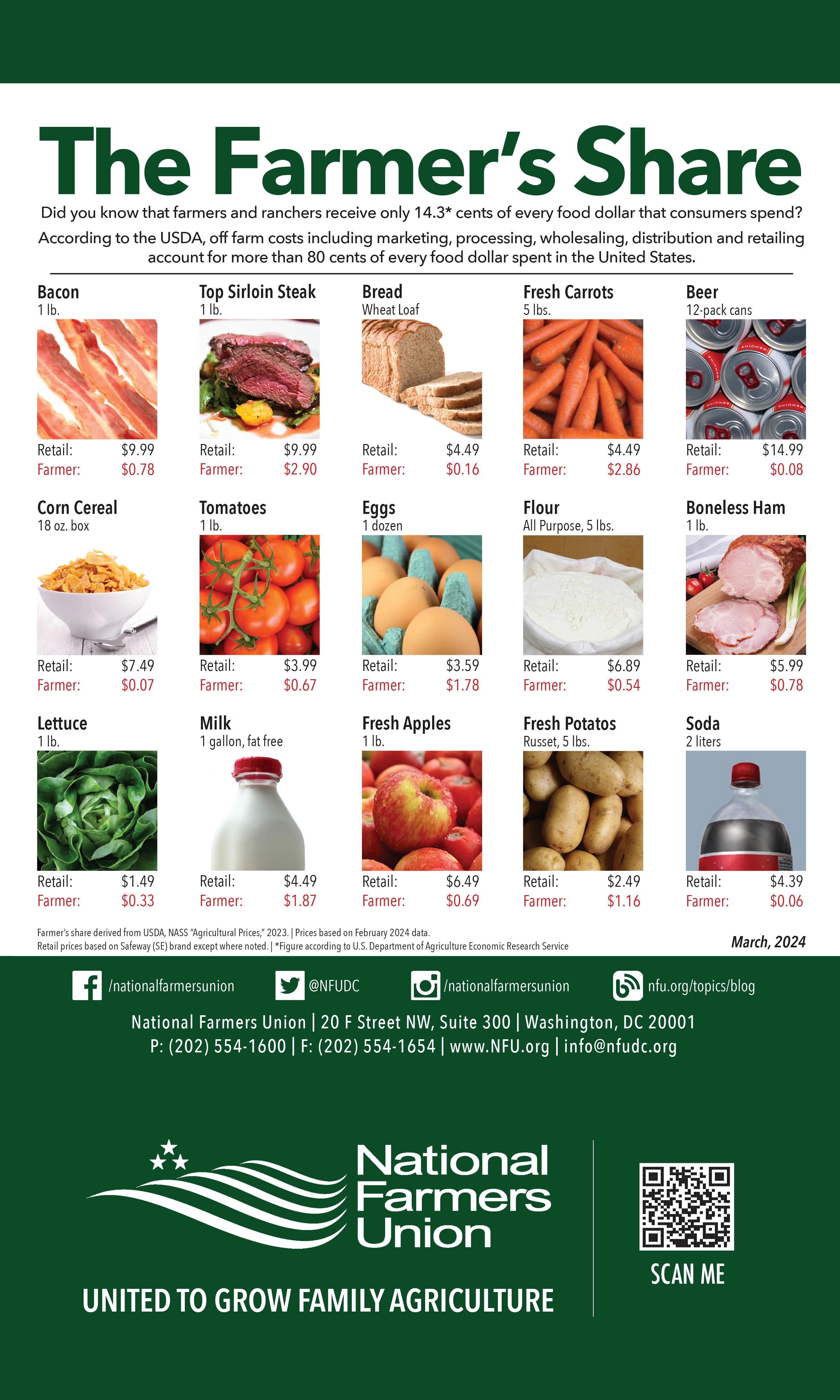
The Farmer’s Share















/nationalfarmersunion @NFUDC /nationalfarmersunion nfu.org/topics/blog Farmer’s share derived from USDA, NASS “Agricultural Prices,” 2024. | Prices based on March 2024 data. Retail prices based on Safeway (SE) brand except where noted. | *Figure according to U.S. Department of Agriculture Economic Research Service
Visit nfu.org to learn more UNITED TO GROW FAMILY AGRICULTURE
farmers and ranchers receive only 14.3* cents of every food dollar that consumers spend? According to the USDA, off farm costs including marketing, processing, wholesaling, distribution and retailing account for more than 80 cents of every food dollar spent in the United States. Retail: $5.99 Farmer: $0.79 Bacon 1 lb. Retail: $9.99 Farmer: $2.87 Top Sirloin Steak 1 lb. Retail: $4.49 Farmer: $0.15 Bread Wheat Loaf Retail: $4.49 Farmer: $2.38 Fresh Carrots 5 lbs. Retail: $17.49 Farmer: $0.07 Beer 12-pack cans Retail: $7.49 Farmer: $0.06 Corn Cereal 18 oz. box Retail: $3.99 Farmer: $1.09 Tomatoes 1 lb. Retail: $3.29 Farmer: $2.38 Eggs 1 dozen Retail: $6.89 Farmer: $0.55 Flour All Purpose, 5 lbs. Retail: $6.49 Farmer: $0.79 Boneless Ham 1 lb. Retail: $2.49 Farmer: $0.42 Lettuce 1 lb. Retail: $4.39 Farmer: $1.77 Milk 1 gallon, fat free Retail: $1.29 Farmer: $0.62 Fresh Apples 1 lb. Retail: $4.49 Farmer: $1.03 Fresh Potatos Russet, 5 lbs. Retail: $1.25 Farmer: $0.06 Soda 2 liters National Farmers Union | 20 F Street NW, Suite 300 | Washington, DC 20001 P: (202) 554-1600 | F: (202) 554-1654 | ww w.NFU.org | info@nfudc.org April, 2024
Did you know that
Farmers Union CAMP
GRADES 3-6* (4 DAYS, 3 NIGHTS) – $135**
GRADES 7-12* (5 DAYS, 4 NIGHTS) – $175**
*Grade youth will have completed by the end of the school year
**Early bird price. Price will increase $24 after May 15.
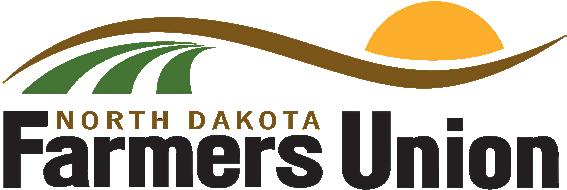




Register using the NDFU Mobile app or at NDFU.org!
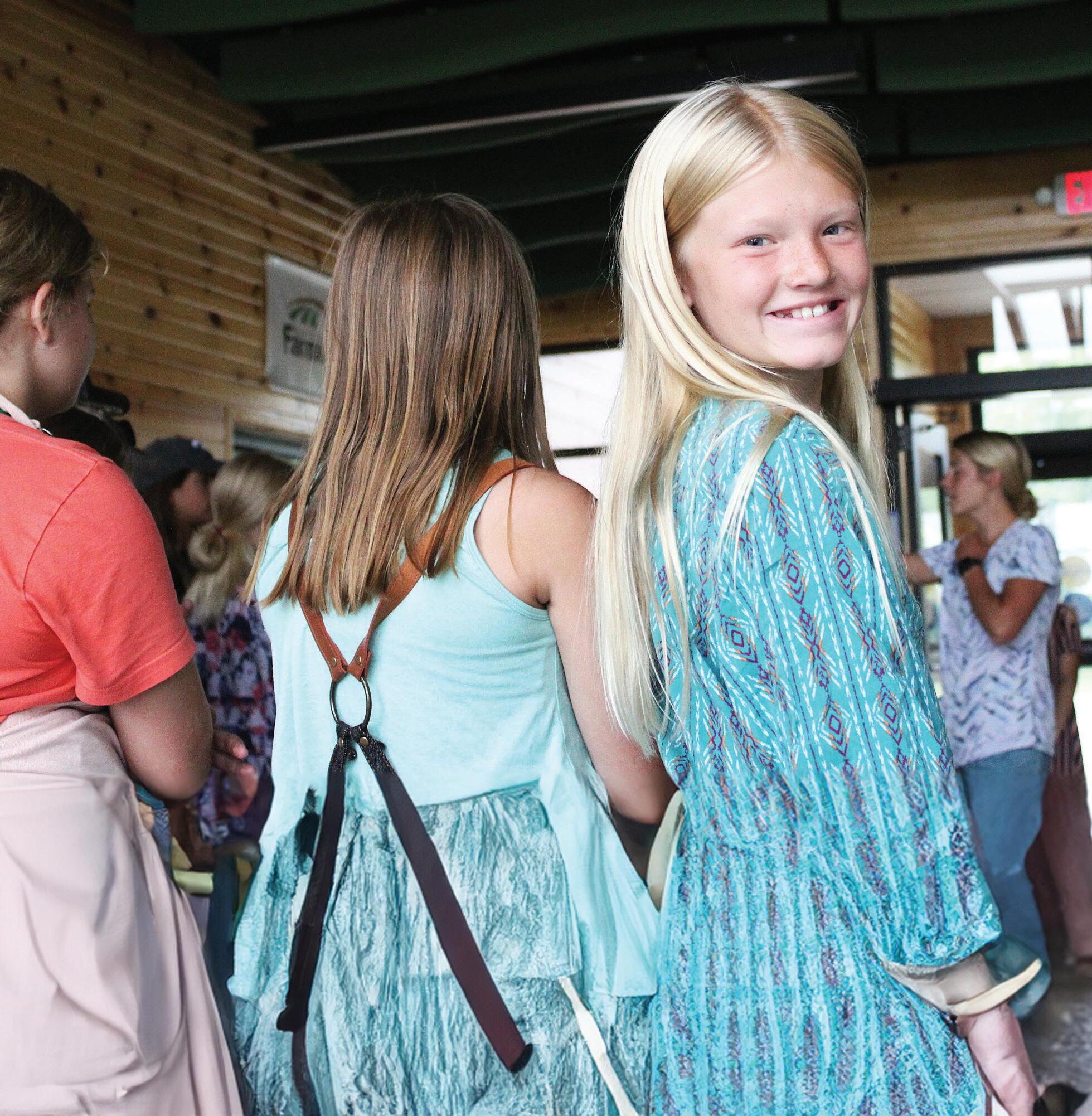
SENIOR CAMP
• June 11-15 –Heart Butte, grades 7-12
• June 18-22 – James River, grades 7-9
• July 8-12 – James River, grades 7-12
• July 9-13 – Heart Butte, grades 7-9
• July 29-Aug. 2 – James River, grades 10-12
• July 30-Aug. 3 – Heart Butte, grades 10-12

JUNIOR CAMP
Heart Butte ~ near Elgin
• June 17-20 – Bottineau, Burke, Divide, McHenry, Mountrail, Renville, Ward, Williams
• June 24-27 – Adams, Bowman-Slope, Grant, Hettinger, Morton, Sioux
• June 30-July 3 – Statewide
• July 16-19 – Burleigh, Sheridan
• July 23-26 – Billings-Golden Valley, Dunn, McLean, Mercer, McKenzie, Oliver, Stark
James River ~ near Jamestown
• June 10-13 – Benson, Cavalier, Eddy, Foster, Grand Forks, Griggs, Nelson, Pembina, Pierce, Ramsey, Rolette, Steele, Towner, Traill, Walsh, Wells
• June 25-28 – Statewide
• June 30-July 3 – Cass, Ransom, Richland, Sargent, Stutsman
• July 15-18 – Statewide
• July 22-25 – Barnes, Dickey, Emmons, Kidder, LaMoure, Logan, McIntosh

AWARD TRIPS
(invitation only)
April 27-28 7th & 8th Grade Lock-In (Jamestown)
June 24-28
All-States Leadership Camp (Minnesota)
July 22-25 Third-Year Award Trip (Twin Cities)

Your name will be entered into our prize drawing when you use the NDFU mobile app to register your kids for camp!
Win a 6-gal. YETI cooler, 2-gal. cordless DeWALT wet-dry HEPA vac or $100 CENEX gift card.
6 • February 2020 • Union Farmer
Register using the NDFU app for a chance to win!

POLICY HOPPER
FROM NORTH DAKOTA FARMERS UNION
Breaking down crop insurance, FARMER Act
On April 9, NDFU President Mark Watne joined Sen. John Hoeven at a press conference announcing the introduction of the FARMER Act. The bill would make higher levels of crop insurance coverage more affordable, reducing the need for ad hoc disaster programs. This article provides an overview of crop insurance use in North Dakota, breaks down the details of the FARMER Act, and discusses where the proposal fits in the farm bill debate.
CROP INSURANCE IN NORTH DAKOTA
North Dakota farmers heavily utilize crop insurance to protect them from yield losses and seasonal price shifts. In 2023, North Dakota ranked second nationally with over $1.5 billion in total crop insurance premiums. The state also ranked second in total premium subsidy

with just over $1 billion.
While we heavily utilize crop insurance, crop insurance is expensive for North Dakota farmers. Total liabilities, the amount an insurance company will pay for a total loss, were $9.9 billion in North Dakota in 2023. For comparison, Iowa had the highest total liabilities at $20 billion. In Iowa, one dollar of premium got a producer $17.17 in coverage, on average. In North Dakota, one dollar of premium got a producer just $6.58 in coverage. Ultimately, the high cost of coverage in North Dakota means that higher levels of coverage are often unaffordable. In Iowa, the average coverage level for revenue protection policies is 81%, compared to 74% in North Dakota. Figure 1 below illustrates the percent of acres covered at each coverage level for revenue
1. Percent of Acres Covered by Coverage Level, Revenue Protection Iowa & North Dakota, 2023
0% 10% 20% 30% 40% 50% 60% 70% 50% 55% 60% 65% 70% 75% 80% 85%
IA ND
Figure

protection policies in 2023. In Iowa, four out of every five acres were covered at the 80% level or higher. In North Dakota, just 10% of acres were covered at 80% and 0.4% were covered at the 85% level.1
THE FARMER ACT
The FARMER Act would address the existing crop insurance subsidy cliff for higher levels of crop insurance, which currently makes higher levels of coverage difficult to afford for many farmers. The legislation would boost subsidy rates for 80% and 85% coverage levels for enterprise or whole farm units (See Table 1 above). The legislation applies to both revenue protection and yield protection policies.
The legislation also strengthens the Supplemental Coverage Option (SCO). SCO provides additional coverage above the underlying crop insurance policy up to 86%. For example, a producer with a coverage level of 75% on their underlying policy, could purchase SCO to cover the band of risk between 75% and 86% of their guarantee. The FARMER Act increases the subsidy level for SCO from 65% to 80%. The bill also increases the maximum SCO coverage level from 86% to 90% and directs RMA to study improvements to SCO for farmers in large counties.
THE FARM BILL DEBATE
Given the growing importance of crop insurance, the FARMER Act is an important piece of the farm bill debate. Sen. Hoeven was joined on the bill by six of his Republican Agriculture Committee colleagues, including Ranking Member John Boozman (R-AR). The FARMER Act also has broad support from national and state commodity groups.
While no Democrats cosponsored the FARMER Act, there appears to be bipartisan

agreement on strengthening crop insurance.
In January, Senate Agriculture Committee Chairwoman Debbie Stabenow sent a “Dear Colleague” letter highlighting crop insurance improvements as one of her top priorities.2 In response to the FARMER Act, Stabenow said she was “glad” to see Hoeven’s proposal introduced.3 Where Stabenow and Hoeven differ is that Stabenow has proposed requiring farmers to choose between purchasing enhanced crop insurance coverage or enrolling in commodity support programs.
NDFU has been a strong advocate for strengthening risk management tools and farm safety net programs. Since 2018, both crop insurance and the countercyclical safety net have proven inadequate in the face of market and weather volatility, forcing farmers and ranchers to rely on ad hoc relief. While needed, those ad hoc programs have provided uncertain and inconsistent relief. Politically, ad hoc programs are not a sustainable solution. At the end of the day, we need a farm bill that provides consistent and reliable relief. The FARMER Act is an important piece to that puzzle.
NDFU Government Relations Director Matt Perdue can be reached at mperdue@ndfu.org
SOURCES
1USDA, Risk Management Agency. (2024, April 16). Summary of Business. Retrieved from https:// public-rma.fpac.usda.gov/apps/SummaryOfBusiness/ ReportGenerator.
2Stabenow, Debbie. (2024, January 17). Farm Bill “Dear Colleague” Letter. Retrieved from https:// www.hagstromreport.com/assets/2024/2024_0118Stabenow_crop_insurance_letter.pdf.
3Hagstrom, Jerry. (2024, April 11). Farm Bill Talks and Crop Insurance Plan. Progressive Farmer/ DTN. Retrieved from https://www.dtnpf.com/ agriculture/web/ag/news/article/2024/04/11/ stabenow-sees-promise-gop-proposal.
NDFU.org • May 2024 • 9
Table 1. Subsidy rates by unit type and coverage level

NDFU MOBILE APP How to use the
Members can use the same email address and password they use for the NDFU portal to log into the app. If you do not know your password, use the “Forgot Your Password” option. NDFU must have an email address on file for you to use the app. If we do not have an email address for you, please call 1-800-366-6338 or email us at ndfu@ndfu.org to have it attached to your account.

1
Login with your email address and password. Use the email address where you receive your NDFU communications.
If you don’t know your portal password, use the Forgot Your Password option!

2
Follow the on-screen prompts to login. NDFU utilizes two-factor authentication for security purposes.
Choose to receive your two-factor code via text or email!

3
Enter the code to get into the app. If the texting option does not work the first time, try again and choose the email option.
You will stay logged into the NDFU app continually, providing you open the app once a month!


FREQUENTLY ASKED
QUESTIONS
Do I have to be a member to log into the app?
Yes. The app is for NDFU members. Those who would like to become members can sign up at NDFU.org!
What if NDFU doesn’t have my email address? Like any online service, we require an email address to use the mobile app. Contact us at 1-800-366-6338 or ndfu@ndfu.org to have an email address added to your account. Additionally, if we have a different email address on file than the one you’re currently using, you can use the one we have on file or contact us with your new address.

NDFU has my email, but I’ve never used the online portal. What’s my password? Search NDFU in the app store or scan the QR code. Download the app, use the Forgot Password link on the login screen and follow the on-screen prompts to set a new password!
Register for camp using the NDFU app for a chance to win! Your name will be entered into our prize drawing when you use the NDFU mobile app to register your kids for camp!
YETI cooler
• 6-gal.
cordless DeWalt HEPA vac
• 2-gal.
CENEX gift card.
continue
the Communications Department
701-952-0118
caarhus@ndfu.org.
• $100
If you
to have trouble logging in, contact Chris Aarhus in
at
or

 Tuttle Farmers Elevator
Tuttle Farmers Elevator
12 • May 2024 • Union Farmer
Farmers Union Oil of Pettibone
Pettibone co-op helps out after fire
BY CHRIS AARHUS, NDFU
When a building fire destroyed the bulk fuel truck for the Tuttle Farmers Elevator in midMarch, its members could have faced major service disruptions.
But in the true spirit of cooperatives, Farmers Union Oil of Pettibone stepped in to help. Tuttle Farmers Elevator continues to borrow the Pettibone truck while waiting for delivery of a new truck.
Jim Hotovec, general manager of Farmers Union Oil of Pettibone, said offering help is part of living in the countryside.
“It was the neighborly thing to do,” he said. “We’re out here in rural North Dakota. All you have is each other. We reached out right away and said, if you need help with hauling fuel or if you want to come take the truck, you sure can.”
Tuttle Farmers Elevator manager James Hirschkorn said it’s been a good arrangement.
“We’re borrowing it a couple of days a week,” Hirschkorn said. “It’s actually worked out pretty good.”
Separated by 24 miles of pavement, it stands to reason the two co-ops would have an overlapping customer base. In another world, a business might take advantage of a service disruption to a nearby business. But not in the co-op world, Hotovec said.


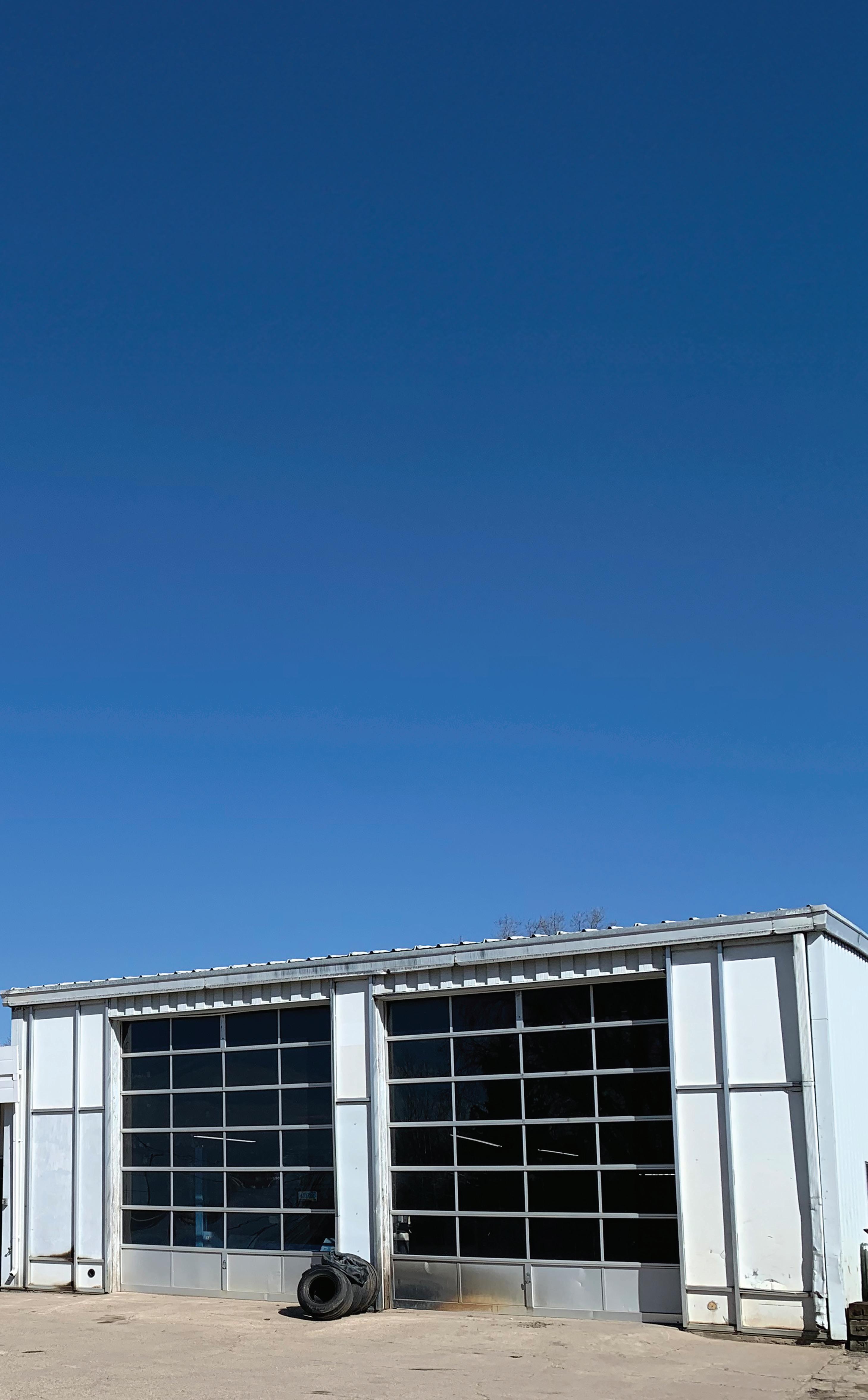
“Economics 101 doesn’t apply out here,” he said. “You have to support what you have. I do a little business over there myself and patronize them, and I’m sure they have employees that come over here.”
Hirschkorn said the new truck is on its way and could be delivered by the end of April. Hotovec added that his co-op has been glad to help.
“We’re just off the beaten path out here, and these small-town co-ops are vital,” Hotovec said. “Without them, you’re driving 50-60 miles to get a bolt. If you can help a neighbor out, that’s what you do.”
Jim Hotovec general manager Farmers Union Oil of Pettibone
James Hirschkorn general manager Tuttle Farmers Elevator
the fourth children’s book from North Dakota Farmers Union

$16.95 plus tax

Dusty learns about generations of family and equipment on their farm, and the latest in soil technology. Find out how Dusty makes Gramps a new thingamajig for his tractor to save the day!
Our Famil





Family Farm GET 4 BOOKS FOR $55 + tax NOTE: only ONE “Where Roots Run Deep” book is included in $55 deal © North Dakota Farmers Union Foundation Sullivan Our Family Farm Cows on the Mooove! NDFU visit ndfu.org to purchase your books online or call the state office at 1-800-366-6338 Book Series


family life in farmers union
16 • May 2024 • Union Farmer
Story and photos by Chris Aarhus, NDFU
THE HELD FAMILY

Held family of Egeland continues long commitment to NDFU
Roger Held was born into a family that was active in Farmers Union.
A third-generation farmer, Roger remembers the vital role Farmers Union played while growing up northeast of Egeland, starting with his grandfather Wilhelm being active in cooperatives and continuing when his father Ed was a director on the Towner County Farmers Union board.
“Farmers Union didn’t exclude you for being a small or big farmer,” Roger said. “Like-minded people involved for the same reason."
CONTINUES ON NEXT PAGE
NDFU.org • May 2024 • 17
FROM LEFT: Roger and Lisa Held (sitting) holding Dally (left) and Norah. Standing behind is Jerad Gefroh and Karly Held.
INSIDE THE WHEEL: Daniel, Evan and Tate (in front).
AT RIGHT: Kayla and Adam Held, and Rachel and Chris Houle.
The Held family from Egeland is the latest to be featured as part of North Dakota Farmers Union’s “Can’t NDFU Without U” campaign, which kicked off last October.
Roger and Lisa Held live on the home place where they raised three now-adult children: Rachel (Houle), Adam and Karly. All three children earned the prestigious Torchbearer Award, the highest honor achieved in NDFU’s youth program.
“The whole family went through it,” Roger said. “The youth program was great. You learn a lot about cooperatives and how those businesses run, and they have a lot of fun with it. (The kids) have made friends that they still keep in contact with, so it becomes more than friends. It’s like family.”
Wilhelm immigrated to the United States in the late 1800s, homesteading 16 miles west of the current farm. Later, he bought the current farm and raised his family there.
For Roger, the introduction to Farmers Union came through cooperatives, not uncommon for many Farmers Union families. Roger said his grandfather’s love for cooperatives likely started when the electric cooperatives brought power to the farm. His father used cooperatives regularly, and the family has long had Farmers Union Insurance.
“I always remember the fuel guy from Farmers Union coming out from Rock Lake –Dad always was a big believer in co-ops,” he

said. “We hauled our grain to a cooperative elevator. He even went to the Farmers Union and bought a stove and a fridge and freezer, and an electric motor for the washing machine.”
The love for Farmers Union has continued to this day. After his father and brother served on Towner County’s board, Roger continues as Towner County’s vice president, while Adam is a director. Karly is the county’s EPIC (Education Program In Counties) coach. And when the entire family heads to Bismarck as delegates to NDFU’s state convention every December, Rachel stays back to watch the livestock.
ADVOCATING
Rachel, who is married to her husband Chris and has four children, said the Farmers Union memory she’s most fond of is riding with her dad to the Rally for Rural America in March of 2000 when she was 10 years old.
“I remember driving through Cincinnati, and every kid’s face on the bus was pushed up against the window looking at big-city skyscrapers,” she said. “I remember the big white tents and folding chairs, and yeah, it was crowded. There was a lot of people. You didn’t stray far.”
And she remembers Paul Wellstone, the senator from Minnesota who gave a riveting speech in support of farmers at the rally. Wellstone and members of his family died in a plane crash two and a half years later.
Roger also remembered Wellstone’s passion,
18 • May 2024 • Union Farmer
CONTINUED FROM PREVIOUS PAGE
NDFU is highlighting family farmers and ranchers as part of its “Can’t NDFU Without U” campaign, which it launched across the state in October 2023.
as part of an event that helped make a difference for producers in Washington, D.C.
“I felt it would be a big deal, and it was,” Roger said. “I wanted to be part of it. And Rachel was awfully young at the time, but I’m glad she got to experience it.”
Going to the nation’s capital is nothing new for Farmers Union members. Each September, 30 to 40 members visit Washington, D.C., to advocate for farmer- and rancher-friendly policies at the National Farmers Union fly-in. NFU and all of the state divisions visit all 535 congressional offices.
“You get to go out there, and you get a 1-on-1 with them,” he said. “If we didn’t do that, there wouldn’t really be any other way for us to do it. You can call and write letters. But here,


you’re putting a face to it and letting them know you’re a farmer. They open up and want to know more about what’s going on. Sitting across from them and talking to them is the way to do it.”
That process is what Adam values most when dealing with the problems that hinder farmers and ranchers. And it starts with the grassroots, he said. Adam has taken over the farm’s day-to-day duties.
“(Farmers) are the ones out here every day doing it, and they know what’s best for them and best for their communities,” he said.
Adam said being able to follow the grassroots policy process from the county CONTINUES ON NEXT PAGE
NDFU.org • May 2024 • 19

CONTINUED FROM PREVIOUS PAGE
level and effect change within the organization makes farmers feel heard.
“You can go to Farmers Union and say, hey, this idea that we have maybe doesn’t work in our area,” said Adam, who lives west of the farm with his wife Kayla and two children. “Can we change it? Can we flex this and move it around a bit? I feel like they listen. Sometimes it works out, and sometimes it doesn’t. But they listen.”
Adam said he’s concerned about right to repair issues and corporate consolidation in agriculture.
“I think our newest piece of equipment is probably 18 years old, so we like the fact that we can pull something into our shop, work on it and fix it,” he said.
For young and beginning farmers, access to capital and land continues to be a problem, he said.
“We’re probably about the smallest operation around here, excluding the guys who are winding down their operations,” Adam said. “If you don’t have a foot in the door, it’s about impossible. That and the working capital. It’s expensive to put in your first crop.”
EDUCATING
The Held family believes in education – Lisa, Rachel, Karly and Kayla are all teachers. And they back it up, as the family has been a steady presence within NDFU’s youth education program. Each had their favorite memories, but Lisa’s was clear.
“Mine was (watching) the kids get their Torchbearer Awards,” she said. “They all earned it.”
Karly has carried Towner County’s program forward and now helps other kids earn their Torchbearer Award as the youth director, which she started four years ago. Her earliest camp memories started at Mouse River Farmers
20 • May 2024 • Union Farmer


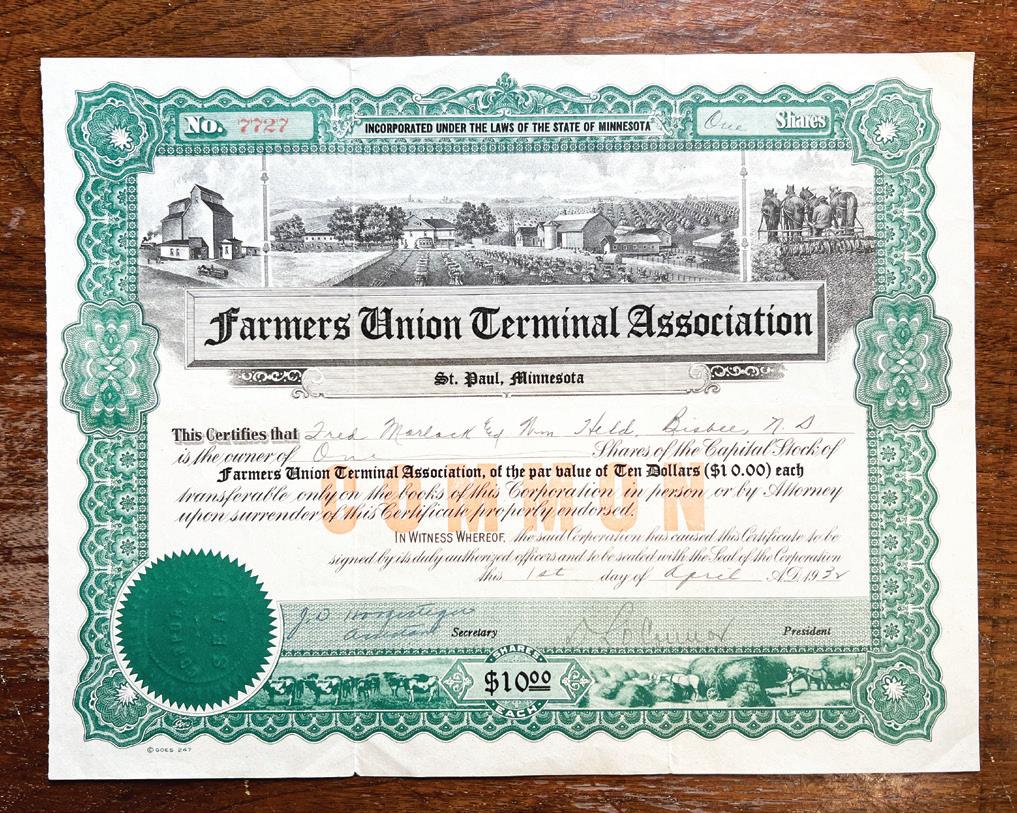
Union camp near Velva. The camp did not recover from the historic 2011 flooding of the Mouse River.
“It was heartbreaking, because going there was such a big part of the summer,” she recalled. “Then we took the long bus ride to (Heart Butte), but it was worth it. It was worth every second. You get on that bus on Monday morning with complete strangers, and you come home family. You don’t forget those people.”
A big part of the experience is learning about cooperatives, including running a co-op store. She said the games are also cooperativeminded, and campers often come out of their shell and grow as individuals.
“Working together with others, you learn how to communicate,” said Karly, who also represented NDFU on NFU’s National Youth Advisory Council. “There’s a self-confidence that counselors instill in you, and that’s why I still remember many of my counselors. They truly believe in every camper and teach you
Pictured here is the a stock certificate worth $25 in Farmers Union Central Exchange (Cenex) purchased by Roger Held's grandfather Wilhelm Held in 1932. The certificate is signed by the first president of the exchange C.C. Talbott, who was also NDFU's first president.
Pictured here is a stock certificate worth $10 in Farmers Union Terminal Association (the elevator cooperatives) by Roger Held's grandfather Wilhelm Held in 1932.
great things in the five days you are there.”
Karly believes the communication skills learned at camp can aid campers for the rest of their lives.
“It’s that importance of communicating and doing it in a respectful manner so that you can still get your point across without being rude about it,” she said.
Many years of being involved with Farmers Union at the local, state and national levels have paid dividends for the Held family. Roger said he wouldn’t trade his experiences for anything.
“The farmer never really quits being educated,” he said. “The amount that I’ve learned through Farmers Union is priceless. With the speed at which we’re getting information now, Farmers Union keeps you updated about what’s going on.
“With all of the opportunities they have provided me, they’ve given me a lot more than I’ve given them.” n
NDFU.org • May 2024 • 21

Final P&S Act rule set to take effect in May
USDA issued its second final rule in a series of updates to the Packers & Stockyards Act (P&S Act). The “Inclusive Competition and Market Integrity” rule establishes clearer standards for prohibited practices under the P&S Act, including discrimination, retaliation and deception by packers, contractors and dealers. The final rule takes effect on May 6.
In addition to providing anti-discrimination protections for legally protected classes, the rule bolsters protections for livestock producers and poultry growers who engage in legally protected activities, such as lawful communications or refusals to communicate, asserting contractual and P&S Act rights, and participation in associations and cooperatives. It also supports USDA monitoring, evaluation and enforcement of compliance with aspects of this rule through certain recordkeeping requirements.
While the rule itself does not definitively solve the vexing “harm to competition” issue that has plagued P&S Act enforcement, it does restate from President Joe Biden’s competition executive order, “it is unnecessary under the ... Act to demonstrate industry-wide harm to establish a violation of the Act and the ‘unfair, unjustly discriminatory, or deceptive’ treatment of one farmer” violates the Act.
The rule’s finalization was announced just days after a successful effort by NFU to defeat a harmful policy rider out of the FY24 agriculture funding bill, which was passed as part of a six-bill spending package – known as a “minibus” – in the first week of March. This policy rider was included in the U.S. House FY24 agriculture funding bill proposal and would have blocked enforcement of the recently completed P&S Act rules, while preventing the finalization of the outstanding rules. Its exclusion from the FY24 minibus is a major win for family farmers and ranchers across the country.
In further defense of the P&S Act, NFU Vice President Jeff Kippley penned an op-ed for the publication Agri-Pulse, highlighting the importance of the P&S Act for family farmers and ranchers:
"Given the abundant evidence of price fixing and unfair practices in the livestock industry, it’s clear that maintaining the status quo won’t foster innovation, competition or robust market oversight. It’s time to acknowledge the heavily consolidated and vertically integrated nature of the industry and enact rules that level the playing field for family farmers and ranchers."
At NFU’s 122nd Anniversary Convention, Secretary of Agriculture Tom Vilsack indicated farmers should soon expect more proposed rules to be issued which will address the poultry tournament system and further address the “harm to competition” issue, as well as a possible rule addressing price discovery in cattle markets. NFU will continue working to ensure the P&S Act rulemakings can proceed without interference while urging USDA to swiftly complete the remaining rules.
NFU JOINS PETITION TO FTC IN SUPPORT OF RIGHT TO REPAIR
On Feb. 2, NFU submitted comments to the FTC in support of the Public Interest Research Group’s (PIRG) and iFixit’s petition to pursue rulemaking that will protect farmers’ and consumers’ right to repair.
PIRG and iFixit submitted this petition in late 2023. The petition (“Petition for Section 5 Rulemaking Addressing Consumers’ Right to Repair”) lays out the case for the rulemaking and the necessary components to adequately address consumer expectations. In support of the petition, NFU’s comments urge FTC to establish rules that are consistent with consumer exceptions of product repair and limit the power of consolidated farm equipment
22 • May 2024 • Union Farmer

manufacturers.
NFU believes it is essential that such rules address the consumer expectations, including (but not limited to):
• Consumable components be replaceable and readily available throughout a product’s lifespan.
• Components that commonly break be replaceable and readily available as repair parts.
• Consumers be able to take damaged products to a repair shop of their choice or perform a repair themselves.
• When a manufacturer discontinues support for a product, its key functions remain intact, and an independent repair shop be able to continue to perform repairs.
• Identical components from two identical devices be interchangeable without intervention from the manufacturer.
• Independent repair shops be not required to report customers’ personally identifiable information to the manufacturer.
Furthermore, NFU’s comments highlight consolidation in the industry as a concern, with just three manufacturers controlling the majority of farm equipment production, sales and repairs. High levels of concentration among farm equipment manufacturers have contributed to consolidation among farm
equipment dealers, further exacerbating the problems farmers face accessing repair. This consolidation also impacts small rural businesses that sell and repair agricultural equipment.
NFU’s comments also cite and reject false and misleading claims by manufacturers and dealers that independent repair undermines emissions compliance laws under the Clean Air Act. NFU wrote U.S. Environmental Protection Agency Administrator Michael Regan last June requesting clarification. In his response to NFU, Regan sharply rebuked these claims and expressed EPA’s support for independent repair.
NFU remains involved in a separate FTC complaint against John Deere for its illegal restrictions in the repair market. NFU has championed federal legislation to ensure farmers and ranchers can fix their own equipment. State and regional Farmers Union divisions are leading the charge across the country. Rocky Mountain Farmers Union secured a major win last April with Colorado becoming the first state to enact agricultural right to repair legislation. This law went into effect on Jan. 1, 2024.
A core pillar of the Fairness for Farmers campaign, NFU remains committed to securing the right to repair for farmers and ranchers nationwide.
NDFU.org • May 2024 • 23
Pasture turnout timing critical for optimal forage
Ranchers depend on grass as a primary source of forage, whether it be rangeland, pasture or hay. While they carefully select species to plant as cover crops or plan a total mixed ration, many ranchers do not know the primary grass species their livestock consume.
“Knowing the predominant grass species is important because not all grass is equal,” said Kevin Sedivec, North Dakota State University Extension rangeland management specialist. “Different species have different growth patterns and nutritional content. Thus, the optimal time to graze these resources varies. To achieve optimal forage and livestock production, plan your grazing system around the type of grazing resources available.”
Native grasslands consist of a mixture of cool- and warm-season grasses. Native cool-season grasses begin growing once the average temperature is 32 degrees or greater for five consecutive days, whereas warmseason grasses start growing once the average temperature is 40 degrees or greater for five consecutive days. This results in approximately a one-month difference in when these plants reach grazing readiness.
Pasture, on the other hand, typically consists of cool-season grasses in the northern regions of the United States, and warm-season grasses in the southern regions. Cool-season grasses exhibit rapid growth and need less growing degree days to reach grazing readiness in the spring. This extends the grazing season by enabling ranchers to turn cattle out to pasture earlier in the spring, Sedivec says.
Irrelevant of grass species, grazing before plants reach the appropriate stage of growth for grazing readiness causes a reduction in herbage production by as much as 60%, which can reduce carrying capacity (number of livestock or length of grazing season) and animal performance. Grazing readiness for most domesticated pasture is at the 3-leaf

stage, whereas grazing readiness for most native range grasses is the 3½-leaf stage.
“Drought or poor grazing management can further delay grazing readiness of grasses and reduce subsequent forage production,” said Miranda Meehan, Extension livestock environmental stewardship specialist. “This is especially true for cool-season grasses, which develop tillers in the fall. The development of these tillers has a direct impact on plant growth the next growing season.”
NDSU Extension has found heavy grazing use of more than 80% in the fall can reduce forage production of cool-season dominated rangeland and pasture by over 50% the following grazing season.
If livestock grazed tillers of cool-season grasses below the bottom two leaves in the fall, the tillers likely did not survive the winter, Meehan says. If they do survive the winter, plant vigor (health) is low and forage production reduced. Drought stress also affects the survival of fall tillers. Fall droughts either don’t allow buds to come out of dormancy, thus preventing new tiller growth, or cause death to those tillers that did grow. If tillers do not establish or survive the winter, a delay in growth and development will occur the following growing season because new tillers will need to develop in the spring. This loss of fall tillers can create a delay in grazing readiness the following spring by 10 to 14 days. When drought and poor grazing management in the fall occur simultaneously, grazing readiness can be delayed even longer.
“Drought-stressed pastures will require special care this spring to help them recover,” Meehan said. “These pastures must be given adequate time to recover. Grazing too early will reduce plant vigor, thin existing stands, lower total forage production, and increase disease, insect and weed infestations. Pastures and range damaged by grazing too early may take
24 • May 2024 • Union Farmer
several years of deferment or even rest before the stand regains productivity.”
NDSU Extension specialists observed as much as a three-week delay in grazing readiness for introduced cool-season species and a four-week delay for native cool-season species following drought.
Consider these grazing management strategies to optimize forage production and livestock performance:
Determine the predominate grass species in your pasture and rangeland.

Continue dry lot feeding in May.
If grazing cannot be delayed, minimize the impact to a small area of your pastures or in one of your cells. Then rest that cell or area the remainder of the grazing season and defer from grazing the next year (no spring grazing).
While it may be tempting to start grazing early due to a lack of forage resources, it can have long-term impacts on forage production and plant health.
Monitor grazing readiness of predominate grass species and delay grazing start date until these species reach grazing readiness. For more information, refer to the NDSU Extension grazing readiness resources: ag/grazing2024.
KEVIN SEDIVEC
NDSU Extension range management specialist
Monitor grazing use throughout the grazing season.
Depending on your forage resources and growing season conditions, it can be difficult to delay grazing until grasses reach grazing readiness. Meehan and Sedivec recommend the following strategies, depending on the resources available:
Start grazing annual forages, such as winter cereals, or domestic cool-season pastures, which will reach grazing readiness earlier in the spring.
Provide supplemental forage to livestock on domesticated pasture or hay land. However, be careful not to graze your hay lands too early, too short, or if muddy, as stands will be dramatically reduced in forage production due to reduced vigor and plant damage, leading to new infestations of weeds.
“While it may be tempting to start grazing early due to a lack of forage resources, it can have long-term impacts on forage production and plant health,” Sedivec said. “Remember, it takes grass leaves to replenish the root food reserves needed to grow grass. Early spring grazing, especially following a drought, can be costly in terms of total forage production during the entire grazing season.”
As the grazing season progresses, NDSU Extension specialists recommend monitoring the degree of use to prevent negative impacts to developing tillers, especially in the fall. The recommended utilization level for proper use of grasslands is 40% to 60%, with some native grasses species only tolerating 40% to 50% use. At this level, rangeland utilization is fairly uniform, with 65% to 80% of the height of desirable forage species being grazed. Remove livestock when this level is exceeded.
Article courtesy of NDSU Ag Communications
What's happening




Bottineau County Farmers Union President Tyler Neubauer presents a check to the Willow City Fire Department to purchase equipment needed to assist in grain bin rescue.
Richland County Farmers Union held a shop talk, inviting NDFU President Mark Watne to speak.

26 • May 2024 • Union Farmer
Save dateS the Duluth Sept. 16-21 Branson Nov. 4-10 | Dec. 2-8 Go to NDFU.ORG/TOURS for details or call 800-366-6338 to book your seat!
Sioux County Farmers Union teamed up with Selfridge Public School on March 28 to assemble meal boxes for students and their families.
around the state?



Stark and Dunn counties held a combined EPIC event at the bowling alley in Dickinson. The event featured bowling, pizza, swag and visiting in what was a fun event for both kids and parents.
Burleigh County Farmers Union board members Denise Brown, left, Randy Ryberg and Bill Kershaw present Wing Principal Cassidy Ziesch with a copy of an NDFU children's book to add to its library during the Wing family fun night hosted at the Wing School.
Ward County Farmers Union board members attended the retirement celebration of longtime Enerbase CEO Tony Bernhardt on April 1.
NDFU.org • May 2024 • 27

Prioritizing sustainability in the food chain
For Farmers Restaurant Group, sustainability is not a catchphrase nor a single “earth day” promise. It’s interwoven into the DNA of the company, their mission-driven philosophy and their daily operations.
Much like their farmer-owners, Farmers Restaurant Group is invested in the long-term health of the planet, while making delicious scratch-made food and drink. We care about sourcing, working to unbundle the industrial supply chain and supporting American family farmers wherever possible. We build and operate sustainable restaurants, paint with non-volatile compounds, choose efficient HVAC and lighting systems, repurpose wood
from fallen trees and old barns throughout our restaurants, and work to divert their waste from landfills with robust composting and recycling programs and more.
Farmers Restaurant Group is guided by a shared mission with our farmers-owners and is working to change the landscape for how a high-volume sustainable restaurant can be successfully operated. To learn more about all of Farmers Restaurant Group’s sustainability efforts and practices, visit wearefoundingfarmers.com/sustainability.
Farmers Restaurant Group is the management company for NDFU's restaurants
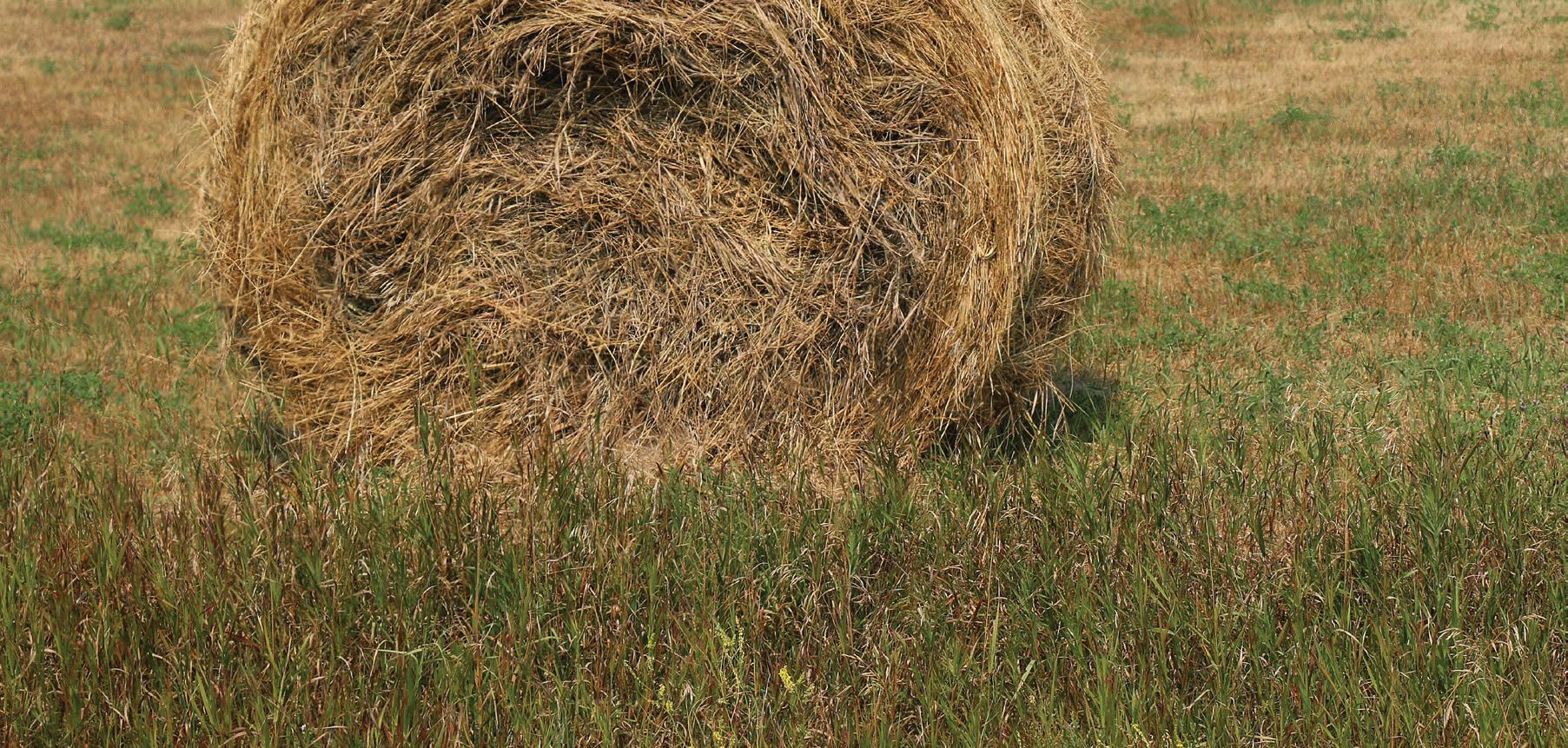

28 • May 2024 • Union Farmer
NDFU is looking for updated information on our members! Use the camera on your phone to scan the QR code, which will take you to an online form to fill out. HAVE YOU MOVED? FOUNDING FARMERS

CLASSIFIEDS
Ads must be submitted through the online form at www.ndfu.org. Click “Classifieds” at the very bottom of ndfu.org and fill out the online form. Ads must be re-submitted each month. No exceptions! Deadline is the 15th of every month. Limit 75 words.
MEMBERSHIP DUES MUST BE CURRENT!
FARM EQUIPMENT
FOR SALE
1948 FORD N, electronic ignition, good tires; Two bottom plow; 7’ sickle mower $5,500 firm. 701-320-4669, Edward Stroh, Jamestown.
VERSATILE TRACTOR, original owner, 1979 875 model. Tractor has 8 new regular bias tires. Overhauled around 1500 hours ago; 1989 John Deere 9600 combine, original owner. High inertia cylinder & concave to match; Three newer low hour straw walkers; 2001 MacDon pull-type 25 ft swather, with pickup reel; 1998 Premier 30 ft swather with bat reel. 701-833-6607, Curt Gilbraith, Mohall.
BULLS/EQUIPMENT, selling pick of 2 or 3 yr. old Red Angus bull. Sold most of cows; Selling parts off JD 7720 and JD 7700 combines. The engines are good. Also selling parts off Vermeer 605J and 605 XL balers. XL has like new flotation tires. 701-339-1141, Marlow Nelson, Powers Lake.
CULTIVATOR/MOWER, bush hog mower; both are 3pt: cultivator is a heavy-duty 6ft., shanks can be removed, movable, and adjusted. $400. Mower is a king kutter, 5 ft. yellow, $700; Two roll corn planter, $500. Three bottom pony drill, IH, $500. Text or email redied@westriv.com for more info and pictures. 701-220-8752, Ed Schwab, Hazen.
15-30 MCCORMICK TRACTOR, 1 New Tire LT245-75R-Load Range E. 2- Cream Separators, David Bradley metal grain box, covered Wagon Running Gear, 12’ Kirschman Drill, 1 Horse Potato Cultivator, 4 Btm. Pony & Packer, Saddle and 2 Bridles. Email: larryn@westriv.com. 701548-8020, Larry Nagel, Shields.
CENEX GRAIN BIN, 2,200 bushel, excellent condition To be moved, no reasonable offer refused; Vintage wood school chair; Farm King auger 60 foot length, side delivery into the side of auger, needs a bearing in main auger, priced to sell; Harley Davidson motorcycle, 1989 Heritage Softtail Classic, 27k miles, one owner, call to get a great price. 701-263-1206, Lathan Romsos, Bottineau.
GRAIN CART, used 450 bu. J-Kraft grain cart, PTO drive, folding auger, hopper tank with bottom auger, nearly new roll tarp, 28L-26 good single tires, reconditioned drives, used 2023 and earlier harvest and planting seasons, good condition, pictures available, $4000 OBO; 1971 Dodge pickup, W-100 Power Wagon, 4WD, 318 engine, 4spd, w/tow hitch, runs but needs work $600. 701-952-8973, Glen Nagel, Jamestown.
EQUIPMENT, 5 bottom Melroe plow & packer
$1000; 7 ft. 620 IH press drill with grass seeder
$1600; 10 ft. 6200 with grass $2000; 14 ft. 620 with grass $2000; 12 ft. 620 rubber press
$1800. Rock picker fork type, twin cylinder
$900; 14ft. Oliver disc $1800. Crown reel type Rock Picker $3400. Lehmann chain stack mower $1800. Drill stem pipe 32ft. $55 each. All machinery has been recondition & can delivery. 701-400-5742, Gerald Miller, Mandan.
WANTED
TRACTORS, IH 706, 806, 1206, 856, 1256, 1456, 966, 1066, 1466, 1566, others; JD 5010, 5020, 6030, 4620, 4520, others; MM 950s on up; Olivers 1964 on up; ACs 200, 210, 220, D-21. Will buy all running or not. 701-628-2130, Jerry Lumley, Stanley.
USED GRAVITY BOX, 250-300 bushel. 701-2693149, Steve Mennis, Jamestown.
FOR SALE
WINCHESTER MODEL 1892, caliber 32WCF (32-20). Octagon barrel, crescent butt. Buckhorn rear sight, good bore. Made 1895, 3 boxes ammo and RCBS dies included. $1250. 701351-3305, Arne Berg, Devils Lake.
LAWNMOWERS; 2020 42" Troy Built, 15.5 hp Briggs & Stratton (used only 1 summer), $1,000; 2006 42" Husky Hydrostatic 17.5 hp Briggs & Stratton, $400. 701-320-4218, Roy Disselbrett, Hatton.
SIGNS, Porcelain signs 8' CO-OP sign with ring no pole and one long OUR OWN HARDWARE store sign, both in very good condition. Mobil, Pennzoil, and Coke cast Iron sign bases once used on lollipop style moveable signs. Trades welcome. 701-220-5746, Val Ganje, Bismarck.
CANOE, 17 ft. AlumaCraft canoe, good condition includes various sizes of life jackets. $750 obo, no checks. 701-226-2649, Craig Wallin, Glen Ullin.
WELDER, Miller Dialarc 250 AC/DC 250 Ampere combination AC/DC welder with electrical control. with many welding rods and two welding helmets $800. Smith acetylene cutting torch and many tips. $250. 701-226-1060, Don Scheeler, Bismarck.
1917 MODEL T, running order. Parade ready. 701-391-2747, Richard Morlock, Steele.
OVENS, 2 commercial Blodgett low temperature ovens, 100-300 degrees, single phase. Would be good for prime rib. $400; ARE topper and Bed Rug carpet kit for a long box pickup. Was on a 03 Dodge, tan in color, pristine condition. $550. 701-640-1412, Daniel Klostreich, Wahpeton.
VAN, 2013 Dodge Grand Caravan, 137K miles, nice shape, just had breaks done. $8000 OBO. 701-597-3525, Scott Nelson, Solen.
WANTED
VW BEETLE, looking for an original Volkswagen Beetle or Bus. Something to drive as is, or to fix up. 701-219-5847, Joel Herman, Harwood.
OLD STUFF, Advertising signs, old gas pumps, advertising thermometers, or most anything that has small town advertising on it. Looking for old road signs that have the Indian Head logo, or those that have reflective marbles, or old metal Highway Patrol Door sign. I also collect ND license plates, ND tokens, ND picked arrowheads, and Red Wing crocks. Will travel to your location. 701-220-5746, Val Ganje, Bismarck.
FORD PICKUP, 1980-86 Ford F150 or F250, 4wd preferably, six cylinder manual transmission, decent shape in North Dakota or eastern Montana. Would consider one with bad engine if the rest of truck is in fair condition. 406-8278620, Leon Helstad, Trout Creek, Mont.
PRAIRIE DOG HUNTERS to hunt on my land. Make reservations now; Used dependable, slower, water cooled snowmobile with electric start and reverse. Email: larryn@westriv.com. 701-548-8020, Larry Nagel, Shields.
FOR RENT, 800 acres of pasture to be rented by bids, located in Sioux County, north of Selfridge. Leasing subject to management guidelines. Sealed bids must be received by June 15, 2024. Owner reserves the right to reject any or all bids. James Blotske, 2631 92nd St., Selfridge, ND 58568. Contact for more information. 701-4223754, Jim Blotske, Selfridge.

MISCELLANEOUS 30 • May 2024 • Union Farmer LAND ALL CLASSIFIEDS MUST BE SUBMITTED ONLINE AT NDFU.ORG/CLASSIFIEDS Classifieds by mail, fax, phone or email will not be accepted.

THANK YOU! FOR YOUR GENEROUS GIFT TO THE NDFU FOUNDATION To those who have already donated ... Donations of more than $1,000 are recognized at the state office on the NDFU Donor Recognition wall. Giving levels include: COBALT – $1,000 to $4,999 BRONZE – $5,000 to $14,999 GOLD – $15,000 and above. The NDFU Foundation was established in 2000 to raise funds for Farmers Union’s renowned youth education program. As a Farmers Union supporter, you are part of a larger mosaic – a piece of the spirit and light – that can help establish a permanent, sustainable fund for NDFU’s youth program. Please consider a donation. Donations can be mailed to: NDFU Foundation, P.O. Box 2136, Jamestown, ND 58402-2136 Please note if the gift is in honor of someone. For more information, contact Lucy Bardell, assistant to the president, at 701-952-0114 or lbardell@ndfu.org.


PERIODICALS –POSTAGE PAID
PO Box 2136
Farmers Educational and Cooperative Union of America, ND Division
1415 12th Ave SE
Jamestown, ND 58402
















































 Tuttle Farmers Elevator
Tuttle Farmers Elevator







































